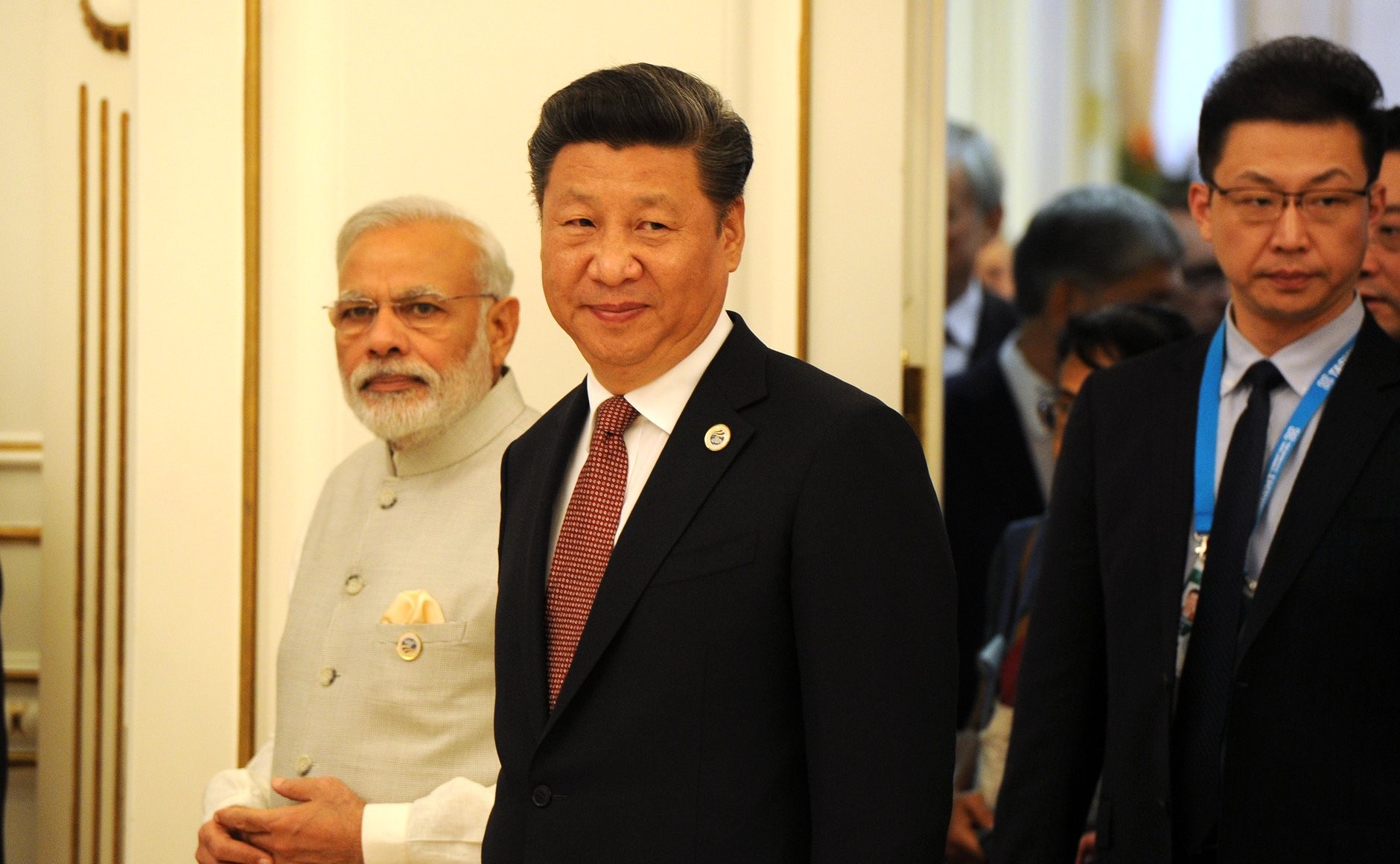The Days After: A Retrospective on Chinese and Indian Media Coverage of the June 16 Border Conflict
How did outlets in India and China cover the border skirmishes?

Published by The Lawfare Institute
in Cooperation With

On June 16, many people in the United States woke up to the news that Indian and Chinese troops had clashed along their contested border in the Galwan Valley, a remote region that sits some 3,000 meters above sea level and frequently experiences sub-zero temperatures. The incident is the first time in recent memory that soldiers have died in combat along the Line of Actual Control (LAC), the long-disputed, de facto boundary separating Indian-controlled territory from Chinese-controlled territory in the mountainous region.
Early reports from the Indian military suggested that three Indian soldiers had died in the fighting but otherwise provided few details. Shortly thereafter, the Indian military revised the number of reported casualties up to 20. China’s People’s Liberation Army (PLA) released a statement indicating that the PLA had suffered “casualties” but did not give any specific number. Details about the fight continued to trickle out in the hours and days after the skirmish. Reports indicated, for example, that neither Chinese nor Indian troops were carrying firearms during the fighting (a product of a 1996 agreement reached between New Delhi and Beijing to reduce the risk of escalation along the border). Instead, soldiers wielded iron bars and threw rocks and punches on the steep, jagged terrain. Many of the deaths occurred when troops fell off mountain ridges. Security analysts grew concerned: The world’s two most populous nations and two nuclear powers had sparred along their shared border and now must decide their next moves.
Some observers hope the two sides will resolve their differences through diplomacy. But there remains a major obstacle to a negotiated settlement: Beijing and New Delhi did not appear to be working from a common set of facts. Chinese Foreign Ministry spokesman Zhao Lijian said the fighting began only after Indian troops crossed the LAC twice. But Indian officials claimed PLA troops ambushed Indian soldiers in an area that China had agreed to vacate. Later in the week, Indian Union Minister and former Indian Army chief Gen (retired) VK Singh said that more than 40 Chinese soldiers were killed in the clash, a claim that Zhao dismissed as fake news.
As each government gave brief public statements—blaming the other side for the conflict but affirming their commitment to deescalation—hundreds of millions of readers in the two most populous countries turned to bloggers, social media and national news sources to make sense of the violent confrontation and its potential consequences. Here, we examine how the conflict was covered in press reports, in opinion pieces and on social media in India and the People’s Republic in the few days following the conflict.
Of course, no aggregation of the reporting will yield a definitive account of what happened that night in the Galwan Valley. Nor does this retrospective attempt to provide insight into how China-India relations might change in the coming weeks.
But an analysis of prominent Indian and Chinese sources shows how events radiated out from the remote border region into two separate media ecosystems. It also sheds light on the tactics each government uses to shape the information environments within their control. And finally, it prods us to consider how powerful nationalistic undercurrents in each country shape public perception of largely opaque events.
Even as outlets in each country worked from different sets of facts, coverage from major Indian and Chinese outlets bore important methodological similarities. Reports from both covered official government statements uncritically, elevated nationalistic rhetoric, and painted the other side as an aggressive dangerous actor, intent on violating basic norms of international law.
Coverage in the People’s Republic of China
Beijing maintains tight control over what media outlets can publish. A complex web of government departments oversee “content management” operations. These include scrubbing the internet of unwelcome phrases and opinions, providing directives to news sources for how they should cover events, and punishing dissenters and their families. Beyond direct government interventions, many Chinese observe soft rules. Conscious that spreading controversial views could have significant personal consequences, Chinese writers, editors and artists must always look over their shoulders.
This does not mean that all Chinese news outlets and bloggers speak with one voice. But it does mean that domestic coverage of high-profile events will stay within a spectrum the Communist Party endorses. Those views that fall outside that range may still trickle through Chinese society, but they are more likely to be expressed in private, using clever codes, or through metaphor and allegory.
In the case of ongoing and sensitive news stories, some prominent Chinese outlets will simply reprint government statements. Indeed, this was the case in the India-China border dispute. On June 16, China’s Ministry of Defense published a statement by spokesperson Zhang Suili, who said that India “deliberately provoked the Chinese side with a violent attack.” A number of Chinese news outlets—including the Paper and Xinhua—immediately reprinted the statement, without further analysis. On June 17, the Global Times, a mouthpiece for the Chinese Communist Party known for strident nationalism, ran a piece entitled “[Chinese Foreign Minister] Wang Yi held a telephone conversation with Indian Foreign Minister and demanded that the Indian side severely punish those responsible.” In the piece, Wang is quoted as saying that India “deliberately provoked the Chinese side with a violent attack” and “seriously violated the basic norms of international relations.” The cycle then repeated: Guancha, Sohu and Sina published Wang’s comments without further analysis.
Meanwhile, on WeChat, a Chinese social media app with some 1 billion users worldwide, popular military bloggers and international relations commentators took nationalist lines. Many argued that a superior PLA had dealt a strong blow to a weak Indian military after the latter violated an agreement and provoked a conflict. TieXue Junshi, which ranks among the most popular military accounts on WeChat, ran a piece entitled “How Many Times Will We Have to Beat India Before They Settle Down?” The piece walks through various conflicts at the China-India border and argues that all of them were India’s fault, and that China beat back India in each case. Another popular military blogger and former PLA Navy rear admiral, Zhang Zhaozhong, authored a piece about the Indian division that sustained losses during the skirmish. He portrays the Indian military as reckless and weak: “They deliberately provoked us and were looking for trouble, and the consequences for them were very serious.”
Some nationalistic opinion writers sought to “uncover” the West’s role in the Sino-Indian conflict at the border. In an article entitled “China-India Border Friction, Cause: Google, Twitter,” blogger Zhou Xiaoping argues that Western sources had cooked up a greater fuss than the facts on the ground warranted, and that certain irresponsible Chinese journalists had irresponsibly picked up and amplified these Western reports. In a since-deleted post from the popular military blogging account 我是大伊万 军武次位面, another military blogger cast doubt on the rumors that the PLA had lost more troops than India. The author argued that these rumors originated in the West, which holds the false conception that the Chinese military is weak. In a piece posted to 军武速递, a popular military commentary account on WeChat, a blogger used media reports and social media posts to track Indian military reinforcements moving toward the Galwan Valley. The author claims that the Indian military had sent an anti-submarine aircraft imported from the United States toward the disputed Himalayan territory.
Perhaps to stir up nationalistic fervor, some Chinese netizens turned to history. Some bloggers uploaded 1962 news articles from the People’s Daily—a Chinese government propaganda outlet—that covered the China-India border dispute from that year. The tone of these pieces is strident nationalism, as is apparent even from their titles: “Angrily condemned India for encroaching on our territory and killing my officers and soldiers, People’s Daily, October 6, 1962” and “We Demand that India immediately stop its armed offensive and withdraw from Dongdong, People’s Daily, October 8, 1962.”
Taking a less inflammatory approach, Chinese academics sought to frame India’s alleged aggression in geopolitical terms. Guo Xuetang, a professor at Shanghai University of International Business and Economics, argues in a piece for China-based Southern Weekly that India was practicing a form of “diplomatic opportunism,” by striking against China as the PRC navigates an antagonistic relationship with Washington. Arguing that India is acting as a regional hegemon, Guo says that “India’s aggressive diplomacy has been around for many years, and weaker neighboring countries have been upset but afraid to voice their anger[.]” Zhang Jidong, a professor at Shanghai’s Fudan University with a focus on international security, wrote a widely read piece titled “Is border confrontation the new normal in China-India relations?” Zhang provides a number of reasons why border conflicts may continue in coming years, even as both sides will have strong incentives to make sure that conflicts do not escalate. Zhang points to rising tides of nationalism in both countries, the expansion of social media, and the Indian government’s need to find a diversion in the face of mounting domestic challenges as a few key factors that drove the conflict. Zheng Yongnian, a professor at the National University of Singapore, wrote a piece entitled “As the Incident at the Border Becomes Serious, Sino-Indian Relations must never be underestimated.” Zheng argues that India’s conflict with China is driven in part by an effort to unite a fractured Indian electorate; but he explains that China must better understand India and build stronger ties, at least in part to ensure that India does not grow too close to the United States.
Coverage in India
In contrast, the Indian media landscape comprises thousands of outlets, diverse in language and political persuasion, and protected by the Indian Constitution’s guarantee that “[a]ll citizens shall have the right to freedom of speech and expression.” Indeed, this value is deeply ingrained in Indian political culture. As one scholar observes, “[F]or most Indians, there is comfort in being able to thrash out our problems through vibrant public debate”—which occurs on the op-ed pages of major newspapers and online publications, on a variety nightly television programs, and on social media. However, the Indian media has been subject to increasing pressure under Prime Minister Narendra Modi’s government, notably when reporting on national security issues and the COVID-19 crisis—moves that the Indian Supreme Court has occasionally been forced to rebut.
In this environment, the Indian government and media largely painted the June 16 incident as a result of Chinese aggression. On June 17, the Ministry of External Affairs issued a press release describing the phone call between the External Affairs Minister Subrahmanyam Jaishankar and Chinese Foreign Minister Wang Yi. This press release diverges from the Chinese government’s portrayal of the phone call, instead stating that “the Chinese side took pre-meditated and planned action that was directly responsible for the resulting violence and casualties.” The statement notes that the escalation from the Chinese side was “unprecedented” and would have “a serious impact on the bilateral relationship.” The release cautions that if China wanted to avoid consequences, it would need to “reassess its actions and take corrective steps.” Several media outlets repeated this statement, and broader articles with independent sourcing also painted the Chinese actors as the wrongdoers.
The Indian government was initially evasive in revealing the number of casualties, or details of the incident. Ultimately, the government conceded that 20 Indian soldiers died in the clash. Around the same time, the Asian News International (ANI) news agency—India’s biggest—reported that there had been 43 Chinese casualties and that there was increased helicopter activity on the Chinese side to airlift the bodies of their soldiers. ANI is known to have a pro-government bent and has been credibly accused of manipulative reporting. The ANI report did not cite any sources, but the claim was still repeated uncritically by some media publications—including the government-owned DD News. Alt News, an Indian organization that serves as a media watchdog, concluded that there was no basis to the ANI report and that the “43 Chinese casualties” number could not be proved at the moment.
On June 19, Modi held a virtual “all-party meeting” with various political parties to brief them on the entire episode. In that meeting, he declared that the 20 dead Indian soldiers “taught a lesson to those who dared to look towards our motherland.” This echoed a statement he had made two days earlier, wherein he had said that the nation should be proud that its soldiers had died while inflicting blows themselves.
However, a different statement from the “all-party meeting” ended up making the news, albeit for the wrong reasons. In order to quiet worries that India had suffered an intrusion into its territory, Modi declared, “Neither [was] anyone inside our territory nor [was] any of our post captured.” But this statement contradicted the Ministry of External Affairs’s earlier statement that China had been trying to build a camp in Indian territory, leading to the stand-off. And Modi’s phrasing could be read as admitting that the territory did belong to China, a particularly dangerous concession because China has claimed sovereignty over the entire Galwan Valley. The next day, the prime minister clarified his statement and bemoaned the “mischievous interpretation” given to it “in some quarters.” Modi claimed that his statement referred to how India’s brave soldiers had foiled an attempt to intrude upon India’s sovereignty and that there had thus been no violation of India’s sovereignty.
In addition to official statements, Indian media outlets drew heavily on satellite imagery of the LAC in their reporting. Analyzing images from U.S. companies such as Planet and Maxar, Indian outlets reported extensively on the Chinese military buildup in the region surrounding the Galwan Valley. NDTV, in particular, analyzed these images to show that in the runup to the clash, the Chinese military was working on infrastructure projects close to the LAC. Using satellite imagery, Indian outlets also reported that Chinese military activity in the area has continued after the skirmish, despite the ongoing deescalation talks.
Indian news outlets also reported extensively on the public reaction and the rise in anti-Chinese sentiment following the June 15 clash. This has included coverage of public demonstrations in states across India, where protesters registered their anger against the Chinese government by burning Chinese flags and effigies of Chinese President Xi Jinpiing, including one instance in which protesters mistakenly burned a representation of North Korean leader Kim Jong Un.
Central to the protests and the broader public reaction have been calls to boycott Chinese goods and turn instead to the government’s “Make in India” initiatives. A diverse array of Indian media outlets have reported on the boycott movement with varying degrees of support. At one end of the specturm, popular nationalistic television anchors such as Arnab Goswami have expressed strong support for the movement. In a recent clip titled “Boycott Chinese goods, teach them a lesson,” Goswami’s show’s voiceover states dramatically, “[I]f India wants to make China pay for its Galwan aggression, it’s time to boycott everything that’s made in China.” At the other end, however, many outlets and opinion writers have challenged the efficacy and feasibility of a boycott. For example, the Hindustan Times ran an article titled “Will ‘Boycott China’ strategy really help?” arguing, "Those championing such ideas believe that our boycott will hurt China economically. Such views are, at best, half-baked. Economic competition between countries, especially ones as big as India and China, is far more nuanced. It requires long-term strategic vision. Foreign trade, at best, can only be one aspect of it."
Additionally, some commentators have noted that aspects of the campaign appear self-defeating. At present, calls to boycott Chinese goods also seem to threaten popular Indian startups that depend on Chinese capital. TN Ninan, chairman and editorial director of Business Standard Ltd., observed in an op-ed titled “To Hit China, aim carefully. Don’t shoot yourself in the foot” that “[b]oycott calls are unlikely to hurt China & Xi Jinping. A tactical approach, like denying it access to strategic markets like telecom products, would be better.”
Nevertheless, the reporting suggests that boycotts against Chinese products enjoy broad support among the general public, prominent citizens and individual politicians. Indian outlets have detailed how, in solidarity with the movement, some celebrities publicly uninstalled TikTok, a Chinese-owned video-sharing and social networking application. The Indian government also appears to be joining the boycott movement. In recent days, the state government of Maharashtra suspended three agreements with Chinese companies worth more than $660 million. The Maharashtra industry minister said, “The decision has been taken in consultation with the Union government. These were signed prior (to the killing of 20 Indian soldiers on the Indo-China border). The ministry of external affairs has advised not to sign any further agreements with Chinese companies.” Similarly, the Indian Telecom Ministry has ordered private companies within its purview to ban Chinese equipment and cancel agreements with Chinese companies. Most recently, the Indian government took the major step of banning 59 Chinese apps, including TikTok and WeChat. According to the Press Trust of India (PTI), a major news agency, Indian communications and information technology minister Ravi Shankar Prasad said, “We banned Chinese apps to protect data of countrymen; it was a digital strike.”
Although the boycott debate consumed much of the national oxygen, the Indian press has also begun reporting on the government’s strategic and diplomatic next steps with respect to China. Indian outlets updated their audiences about the ongoing bilateral talks in Ladakh, specifically noting that Indian representatives urged their Chinese counterparts to “ensure expeditious restoration of peace and tranquility in border areas.” Most outlets (with varying levels of detail) covered the Indian military’s revised rules of engagement at the border, which allow field commanders to authorize the use of firearms at the LAC in “extraordinary” circumstances. Many reporters for Indian publications have also reported on the Indian government’s military mobilization at and around the border since the clash. Notably, unlike the early reports about the clash and the casualties, which relied almost entirely on official government statements, these reports on strategic issues cite anonymous government sources. However, a cynical read of the anonymous sourcing is that these leaks are serving strategic purposes for the government, demonstrating to the Indian public and adversaries that India is serious about fighting for its territorial claims on the border. Regardless, the fact that coverage of India’s next steps uses unofficial government sources distinguishes these stories from the rest of the reporting on this issue.
Finally, a group of commentators writing for Indian media outlets have cast their analysis and recommendations in geopolitical terms rather than in the strict language of nationalism. For example, G. Parthasarthry, former Indian high commissioner to Pakistan, argued for India to actively prevent Chinese dominance in certain economic sectors and to expand its relationship with Taiwan and other regional partners. K.C. Singh, former Indian ambassador to Iran, wrote, “An honourable solution requires China quietly restoring the status quo ante, India accepting to not needle it at WHO … or over Taiwan or Hong Kong.” He continued, “China officially conceding that they too lost soldiers in the melee would also obviate the political need for India to seek to restore honour through armed action.” And former Indian National Security Adviser N.K. Narayanan argued in detail that the June 15 clash must be understood not as an aberration but as a new stage in India-China relations. He also explored a question that has gone largely uncovered by mainstream reporting: Was there an intelligence failure on the Indian side that led the Indian government to underestimate the threat of Chinese activity leading up to June 15? As nationalistic talking points dominate mainstream reporting, the op-ed pages of major publications have served as an important counterweight by exploring more searching questions about the conflict.
Different Substance, Similar Tone
The Indian and Chinese media ecosystems depict very different narratives about what took place in the Galwan Valley. A reader in India likely encountered a wholly separate rendition of events than a reader in China; in each media ecosystem, distinct stories spread about which side was responsible, which emerged with fewer losses, and what should happen next.
However, differences in substance in the reporting from the two countries obscure the way in which Indian and Chinese coverage of this issue has been similar: The major outlets from both countries relied extensively on official government statements, generally covering them uncritically. And what’s missing on both sides of the border? Neither country’s media have produced deep investigative reporting that explains why the clash happened, the response to it or their governments’ long-term vision for the border. This heavy pro-government tint in media coverage is par for the course in Chinese media but is further evidence of a worrying trend in the world’s largest democracy.







